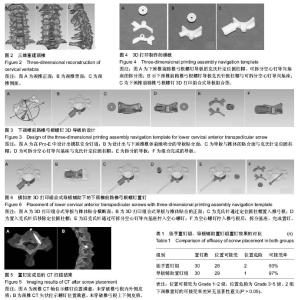| [1] Koller H, Hempfing A, Acosta F, et al. Cervical anterior transpedicular screw fixation. Part I: Study on morphological feasibility, indications, and technical prerequisites. Eur Spine J. 2008;17(4): 523-538.[2] Koller H, Acosta F, Tauber M, et al. Cervical anterior transpedicular screw fixation (ATPS)-Part II. Accuracy of manual insertion and pull-out strength of ATPS. Eur Spine J. 2008;17(4): 539-555.[3] Koller H, Schmidt R, Mayer M, et al. The stabilizing potential of anterior, posterior and combined techniques for the reconstruction of a 2-level cervical corpectomy model: biomechanical study and first results of ATPS prototyping. Eur Spine J. 2010;19(12): 2137-2148.[4] 杨小伟,袁峰,王林,等.前后位X线影像在下颈椎前路椎弓根置钉中的指导意义[J]. 中国骨与关节损伤杂志, 2015, 30(7): 683-686.[5] Koller H, Hitzl W, Acosta F, et al. In vitro study of accuracy of cervical pedicle screw insertion using an electronic conductivity device (ATPS part III). Eur Spine J. 2009;18(9): 1300-1313.[6] 姜恒,单建林,郭光金,等. 颈椎前路手术中椎动脉定位的相关解剖研究[J].第三军医大学学报,2005,27(2):157-159.[7] Smith MD,Emery SE,Dudley A,et al. Vertebral artery injury during anterior decompression of the cervical spine.A retrospective review of ten patients. J Bone Joint Surg Br. 1993;75(3):410-415.[8] Ma T, Xu YQ, Cheng YB, et al. A novel computer-assisted drill guide template for thoracic pedicle screw placement: a cadaveric study. Arch Orthop Trauma Surg. 2012;132(1): 65-72.[9] Merc M, Drstvensek I, Vogrin M, et al. A multi-level rapid prototyping drill guide template reduces the perforation risk of pedicle screw placement in the lumbar and sacral spine. Arch Orthop Trauma Surg. 2013;133(7): 893-899.[10] Kaneyama S, Sugawara T, Sumi M, et al. A novel screw guiding method with a screw guide template system for posterior C-2 fixation: Clinical article. J Neurosurg. 2014;21(2): 231-238.[11] Yang JC, Ma XY, Xia H, et al. Clinical Application of Computer-aided Design-Rapid Prototyping in C1–C2 Operation Techniques for Complex Atlantoaxial Instability. J Spinal Disord Tech. 2014;27(4): E143-E150.[12] Van Cleynenbreugel J, Schutyser F, Goffin J, et al. Image‐based planning and validation of C1–C2 transarticular screw fixation using personalized drill guides. Comput Aided Surg. 2002;7(1): 41-48.[13] Goffin J, Van Brussel K, Martens K, et al. Three-dimensional computed tomography-based, personalized drill guide for posterior cervical stabilization at C1-C2. Spine. 2001;26(12): 1343-1347.[14] Kotani Y, Cunningham BW, Abumi K, et al. Biomechanical Analysis of Cervical Stabilization Systems: An Assessment of Transpedicular Screw Fixation in the Cervical Spine. Spine. 1994;19(22): 2529-2539. [15] Karaikovic EE, Daubs MD, Madsen RW, et al. Morphologic characteristics of human cervical pedicles. Spine. 1997;22(5): 493-500.[16] 徐荣明,赵刘军,马维虎,等.下颈椎前路椎弓根钉内固定解剖学测量及临床应用[J].中华骨科杂志, 2011, 31(12): 1337-1343. [17] 赵刘军,李杰,蒋伟宇,等.下颈椎前路椎弓根螺钉固定系统与普通前路椎体螺钉固定系统的静力学比较[J].中国骨伤, 2014,28(2): 118-122.[18] 李杰,赵刘军,徐荣明,等.下颈椎前路椎弓根螺钉内固定技术的研究进展[J]. 中国骨伤, 2013, 27(10): 873-877.[19] 赵刘军,柴波,蒋伟宇,等.下颈椎前路椎弓根螺钉配套钢板系统的生物力学性能研究[J]. 中华实验外科杂志, 2014,31(2): 385-388.[20] 赵刘军,徐荣明,华群,等.下颈椎前路椎弓根螺钉最佳进钉点和进钉方向的影像学研究及其临床运用[J]. 中国骨伤, 2012, 25(12): 1030-1035.[21] 赵刘军,徐荣明,马维虎,等.下颈椎损伤前路椎弓根螺钉固定的初步临床运用[J].中华创伤杂志, 2012,28(9): 780-784.[22] 王远政,刘洋,陈富,等.下颈椎前路椎弓根螺钉内固定的初步临床应用[J].中华创伤杂志, 2012, 28(8): 697-702.[23] 王远政,刘洋,陈富,等.下颈椎前路椎弓根钉置入相关的解剖学观察[J].重庆医科大学学报, 2012, 37(12): 1063-1068.[24] 邓斌,袁峰,郭开今,等.下颈椎颈前路反向椎弓根螺钉内固定的解剖学实验[J].徐州医学院学报, 2010, 30(8):520-523.[25] Aramomi M, Masaki Y, Koshizuka S, et al. Anterior pedicle screw fixation for multilevel cervical corpectomy and spinal fusion. Acta Neurochir (Wien). 2008;150(6):575-582.[26] Yukawa Y, Kato F, Ito K, et al. Anterior cervical pedicle screw and plate fixation using fluoroscope-assisted pedicle axis view imaging: a preliminary report of a new cervical reconstruction technique. Eur Spine J. 2009;18(6): 911-916.[27] Bredow J, Oppermann J, Kraus B, et al. The accuracy of 3D fluoroscopy-navigated screw insertion in the upper and subaxial cervical spine. Eur Spine J. 2015;24(12): 2967-2976.[28] 胡勇,袁振山,谢辉.快速成型导向模板辅助下经后路寰枢椎经关节突关节螺钉置钉的偏差因素[J].中华创伤杂志, 2013, 29(10): 946-954.[29] 胡勇,袁振山,谢辉,等.快速成型导向模板辅助下寰枢椎椎弓根螺钉置钉的偏差因素分析[J].中华医学杂志, 2013, 93(33): 2659-2663.[30] 胡勇,袁振山,董伟鑫,等.个性化3D 打印"定点-定向"双导板辅助寰枢椎后路椎弓根螺钉置钉技术的安全性和准确性[J].中华创伤杂志, 2016, 32(1):27-34. |

